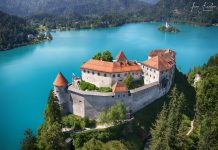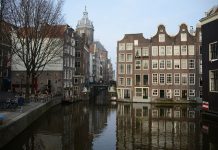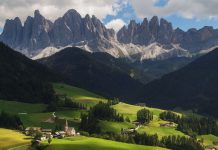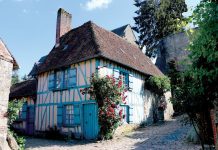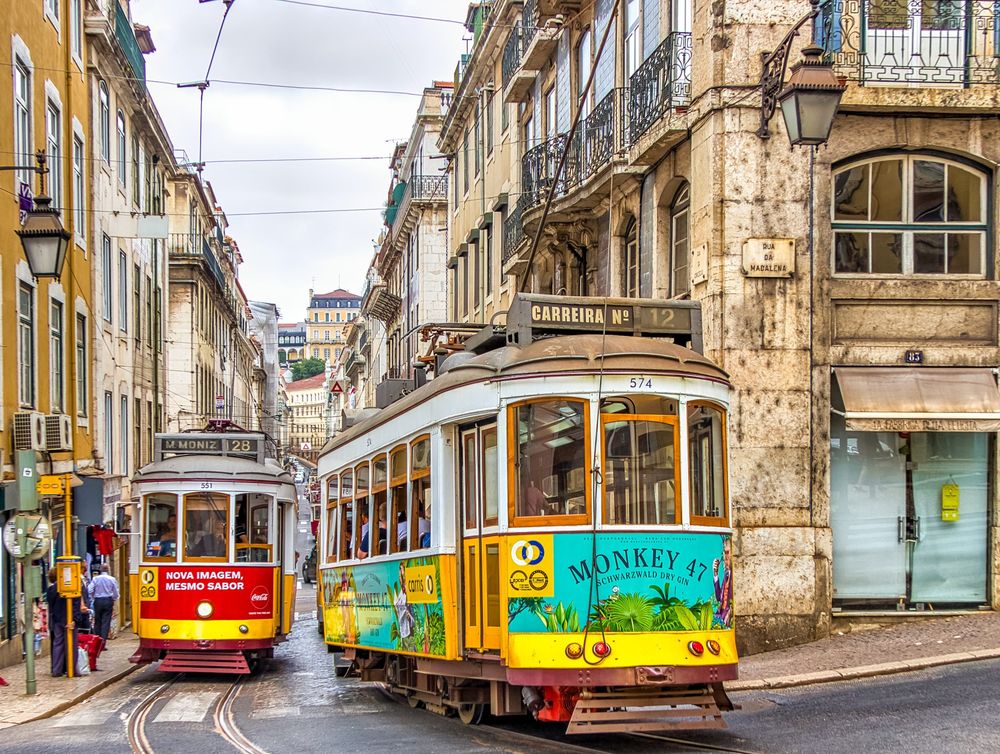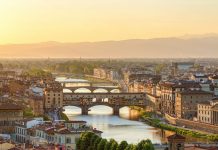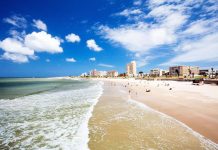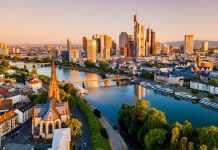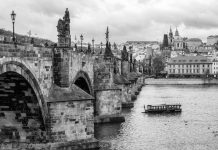Lisbon, the capital of Portugal since 1255, was conquered from the Moors by Portugal’s first king in 1147. It lies on the right bank of the Tagus river and in a region that offers a rich landscape diversity.
The imposing Tagus river (Tejo) flows alongside Lisboa from east to west. Its source lies in Spain, but a good part of its journey to the sea lies inside Portuguese frontiers before it meets the Atlantic ocean. As it approaches Lisboa, the river bed widens to create a green and fertile plain called the lezíria. The effect as it nears the capital is to grace the landscape with its broad blue estuary. The special beauty of the riverbank enriches a number of towns past which the Tagus makes its way: Abrantes, Constância, Vila Nova da Barquinha and Santarém. The whole green river valley is like a stage setting upon which deeply-rooted cultural traditions are enacted. There is popular music and dance, and the traditional costume worn by the horsemen still seen rounding up their cattle in rural pastures is a real feature.
Lisbon, the dazzling city that stretches along the banks of the Tagus, is an enchanting capital. There is the fortress around which the city originally sprang up, and which is now circled by neighborhoods drenched with medieval charm. Everywhere are fine monuments that bring to mind the great Age of Discoveries, and picturesque houses whose facades are decked with ornate ceramic tiles. As the dusk turns to night, the yellow electric tramcars continue to wind their way up and down the hills of the old capital, while the sound of traditional Fado songs enlivens many a candle-lit dinner table in restaurant or home. But the capital also provides ample opportunity for seeing popular celebrations, for shopping, and for enjoying the nightlife along the river bank. With the port and marinas situated nearby, water sports are a natural attraction too.
Not far from the capital lies the town of Sintra, with its marvelous surrounding vegetation and landscape, Sintra is classified by Unesco as of outstanding cultural importance. There is no better way to see the exuberant trees and vegetation than to take a horse-drawn carriage ride and pass by ancient mansions before reaching the Palácio da Pena at the top of the hill. Its fabulous romantic architecture keeps vivid the atmosphere of a truly royal residence.
Back in the Lisboa area, there are many other places worth a visit: the imposing Mafra Convent, the cosmopolitan seaside resort of Cascais, the Arrábida hills and their nature reserve stocked with ancient trees or picturesque Sesimbra, the city of Setúbal and the aristocratic country-houses of nearby Azeitão. The area provides something for every taste: beach, water sports, golf courses and, in the summer, open air music festivals.
The Atlantic coast, which stretches to the south, north and west of Lisbon, is of surprising beauty: here the landscape swiftly changes from high, sweeping cliffs to beaches of white sand, backed by lagoons. Let us not forget that here, at Cabo da Roca, is Europe’s westernmost point. This is a region of enchanting coastal villages or towns such as Sezimbra, Peniche and Nazaré, where the brightly-coloured fishing boats still ply their trade. Further inland, at Alcobaça, Tomar and Batalha, are to be found the ancient monasteries and convents of the religious orders, which are part of UNESCO’s global heritage. They stand as witnesses to Portugal’s rich historical and cultural traditions. These are lands that were won back from the Moors by the first king of Portugal, Afonso Henriques. And the memory of that era lives on in the ancient castles that loom above Leiria, Tomar, Óbidos and Santarém.
Monumental Cistercian Abbey of Santa Maria, founded in 1152 (classified in UNESCO’s International Heritage list). Inside in the church, beautiful Gothic tombs of King Pedro I and Inês de Castro; the cloisters; the chapter house and an enormous kitchen. Churches: Misericórdia (Renaissance portal and 17th-century tiles) and Conceição (17th century).
Batalha
The Monastery of Santa Maria da Vitória was built in answer to a vow made by King John I to the Virgin, if the Castillian’s invader were defeated in the Battle of Aljubarrota. Elected by UNESCO as World Heritage, it is a grand monument to the closing phase of Portuguese Gothic whose building began in 1388.
Cascais
Stylish summer resort. Amongst the numerous restaurants, bars and discotheques are the following historic places: Castro Guimarães Museum and Sea Museum, the 18th century churches of Nossa Senhora da Assunção and Nossa Senhora dos Navegantes; the chapels of Nossa Senhora da Guia (15th century) and São Sebastião (16th and 17th-centuries) and the 17th century fortress. Just a few minutes away lies Guincho beach (a great place for those who enjoy surfing and windsurfing).
Estoril
Renowned worldwide as an important tourism spot (casino, golf course and racing track). The beautiful Santo António Church stands out in this cosmopolitan resort, which also boasts an exciting nightlife.
Fátima
One of the most important Marian centers of pilgrimage in the catholic world. Basilica and Capelinha das Aparições, standing in the place where it is said that Our Lady appeared to the three shepherds.
Leiria
A striking medieval royal castle hangs atop the graceful town of Leiria. Other important monuments: the Cathedral (16th-17th centuries, with an archeology museum on its premises), São Pedro Church (Romanesque), Nossa Senhora da Pena Church (Gothic), Nossa Senhora da Encarnação Sanctuary (16th century).
Lisboa
Spreading out along the right bank of the Tagus, its downtown, the ‘Baixa’, is at the 18th century area of Rossio. East of the arcaded Praça do Comércio, are the medieval quarters of Alfama and Mouraria, crowned by the magnificent St. George’s Castle. To the west lies Bairro Alto and Madragoa, with their typical streets, and on the western extreme lies Belém, with the Belém tower, the Jerónimos monastery (masterpieces of Manueline architecture and classified in UNESCO’s International Heritage list) and the Cultural Centre of Belém.
Museums: Ancient Art, Chiado, Tile Museum, Archeology, Design Museum, Ethnology Museum, Carriage Museum, Costume, Theatre, Maritime, Military, City, Gulbenkian Museum, Modern Art Centre, and the Ricardo Espírito Santo Silva Foundation.
Palaces open to the public: Ajuda and Fronteira.
Churches: Cathedral (with treasury); São Vicente de Fora; Conceição Velha (Manueline), São Roque (with a sacred art museum); Madre Deus; Santa Engrácia Pantheon (Baroque), and Estrela Basilica.
Shopping: downtown; Avenida de Roma, Praça de Londres, Avenida Guerra Junqueiro and shopping centers Amoreiras, Colombo and Vasco da Gama.
Nightlife: Bairro Alto and Avenida 24 de Julho, Alcântara and riverside discos and bars.
The area where the last World’s Fair of last century (EXPO 98) was held is today called the Nations Park, and here are to be found the great Lisbon aquarium, restaurants, leisure activities as well as shows and exhibitions.
Mafra
Palace-Convent, built in the 18th century, is the largest Portuguese religious monument. It consists of royal apartments, magnificent library, bell tower and basilica.
Completely enclosed by lofty medieval walls, this is a small town with whitewashed houses brightened up by colorful bougainvilleas. The massively-towered castle has now been converted into an elegant pousada. Churches: Nossa Senhora do Carmo (Romanesque-Gothic), Santa Maria (Renaissance, housing an art collection by the Portuguese painter Josefa d’Óbidos), Misericórdia (15th-18th centuries) and São Pedro (18th century). Nearby, Senhor da Pedra Sanctuary.
Palmela
Dominated by a magnificent castle, which houses the ancient Santiago Convent (currently a pousada).
Queluz
Summer palace of the kings of Portugal in the 18th century, it encloses a series of rambling and beautiful gardens with lakes and sculptures, and houses an important collection of furniture, paintings, tiles, and decorative arts. Within the palace property stands the Pousada D. Maria.
Santarém
Castle of Roman origin overlooking Portas do Sol (Sun Gates) and opening on to a panoramic view of the Tagus river. Monuments: the Roman-Gothic Church of São João de Alporão (with an archeology museum); the Gothic Convent of São Francisco and the Gothic churches of Graça and Santa Clara; the Renaissance Chapel of Nossa Senhora do Monte; from later periods, the churches of Santíssimo Milagre and Seminário Patriarcal.
Sesimbra
Picturesque small fishing town, with a medieval castle atop a hill. Whilst here, do not miss the Sanctuary of Nossa Senhora do Cabo, at Cabo Espichel, and Lagoa de Albufeira, a favourite spot for windsurfers.
Setúbal
Opposite to the Tróia peninsula (11 miles of beaches and golf courses) lies the city of the Sado river (an important natural reserve). Places of interest: museum, churches of Jesus and São João (Manueline), São Domingos, Boa Hora, Santa Maria da Graça and São Julião. The castle includes a pousada, overlooking Setúbal.
Sintra
(Classified in the UNESCO World Heritage list) In the center stands the National Palace, with its beautiful painted rooms and huge pair of conical chimneys, the village’s ex-libris. Other palaces: Pena (royal palace, 19th century), Seteais (18th century and currently a luxurious hotel) and Monserrate, renowned for its gardens and water courses. The churches of São Martinho (Romanesque origin), Santa Maria (Romanesque-Gothic) and São Pedro de Penaferrim (15th-16th-centuries). Nearby are the church of Santo António do Penedo (16th-century) and Peninha Chapel (Baroque tile works). The Toy Museum, over 20 000 pieces from the 16th to the 20th-century and the Berardo Collection of Modern Art. In the suburbs: the Capuchos Convent (16th-century) and Cabo da Roca (the westernmost point in continental Europe).
Tomar
Christ Convent, classified in UNESCO’s International Heritage list (12th-16th centuries). With its famous Manueline window, it is the town’s supreme landmark. Other places to visit: Templars’ Castle (12th century); churches of Santa Maria do Olival (Gothic), Nossa Senhora da Conceição (Renaissance) and São João Baptista (Manueline); and a 15th century synagogue.
Other places of interest
Abrantes, Almeirim, Azeitão, Azenhas do Mar, Berlengas (islands), Caldas da Rainha, Cartaxo, Chamusca, Colares, Constância, Ericeira, Ferreira do Zêzere, Golegã, Lourinhã, Mação, Minde, Peniche, Porto de Mós, Salvaterra de Magos, Sardoal, Seixal (ecomuseum), Serra da Arrábida (beach and convent), Torres Novas, Torres Vedras, Vila Nova da Barquinha, Vila de Rei, Vimeiro (spa).
Local gastronomy
- Fish soups and stews
- Fish and seafood
- Barbecued sardines and mackerel
- Eels (stew and marinade)
- Azeitão and cottage cheeses
- Sweets: queijadas (cheese tarts) from Sintra and pastéis de Belém (custard cream tarts) from Lisbon.
- Wines: Arruda, Carcavelos, Colares, Palmela, Bucelas, Ribatejo and Moscatel (Setúbal).
Handicrafts
- Glass and crystal from Alcobaça
- Wicker baskets and other objects
- Copper utensils
- Embroideries and lace
- Pottery, artistic and popular ceramics (Caldas da Rainha)

